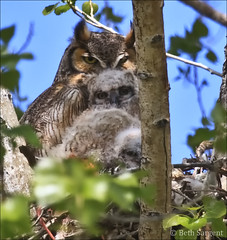From their wings to their eyes, owls have adapted to be some of nature's best hunters.
 Image by Beth Sargent via Flickr• The adaptive Great Horned Owl can be found virtually anywhere in North America. Its habitat includes forest, field, tundra and desert and highly-developed suburban areas.
Image by Beth Sargent via Flickr• The adaptive Great Horned Owl can be found virtually anywhere in North America. Its habitat includes forest, field, tundra and desert and highly-developed suburban areas.• Owls' feathers are especially soft and muffle wind noise. Many owls also have special comb-like fringes on the leading edge of their wings to help channel air, thereby reducing noise. These adaptations allow owls to make a soundless approach towards their prey.
• An old southern legend states that if you hear a Great Horned Owl’s call coming from your left side it is forecasting bad luck for you.
• Many owls can turn their head around about 270 degrees, allowing them to look directly behind themselves. This adaptation has developed to compensate for the fact that their eyes are fixed into a boney socket in the skull and are virtually unable to move.
• Owls' eyes are unique among birds as they are located on the front of the head, instead of on the side. This not only gives them a very human appearance but also enables them to match our level of depth perception that is created by the overlapping vision from each eye.
• Owls can fly and hunt during the daytime as well as at night. However most of them are best adapted for nocturnal hunting.
• Owls' ears are located asymmetrically on their head, with the right ear being higher than the left ear. Each ear hears the same sound with a slight difference, creating a form of audible “depth perception” which can be used to track the location and movements of their prey.
• When fully spread out, the talon of a Great Horned Owl can span up to eight inches wide.
• After digesting their most recent meal, owls will form a pellet of the undigested remains of their prey and regurgitate it. Made up primarily of fur, feathers and bones, it is egested approximately 13-16 hours after eating.
• The Great Horned Owl nests earlier than any other bird of prey in North America.
• When listening to the calls of Great Horned Owls you can distinguish the male from the female by his lower pitch and slightly slower call.
• The Great Horned Owl is probably the longest-lived owl in North America. Banding records confirm numerous owls living into their twenties, with the record lifespan being more than 27 years.
For more information about owls, visit http://www.allaboutbirds.org/guide/search - our online bird guide.
• Owls' ears are located asymmetrically on their head, with the right ear being higher than the left ear. Each ear hears the same sound with a slight difference, creating a form of audible “depth perception” which can be used to track the location and movements of their prey.
• When fully spread out, the talon of a Great Horned Owl can span up to eight inches wide.
• After digesting their most recent meal, owls will form a pellet of the undigested remains of their prey and regurgitate it. Made up primarily of fur, feathers and bones, it is egested approximately 13-16 hours after eating.
• The Great Horned Owl nests earlier than any other bird of prey in North America.
• When listening to the calls of Great Horned Owls you can distinguish the male from the female by his lower pitch and slightly slower call.
• The Great Horned Owl is probably the longest-lived owl in North America. Banding records confirm numerous owls living into their twenties, with the record lifespan being more than 27 years.
For more information about owls, visit http://www.allaboutbirds.org/guide/search - our online bird guide.
Source: BOTM WBU.com
Category ›
Bird of the week
 Unknown
Unknown
 Saturday, August 21, 2010
Saturday, August 21, 2010










No comments:
Post a Comment